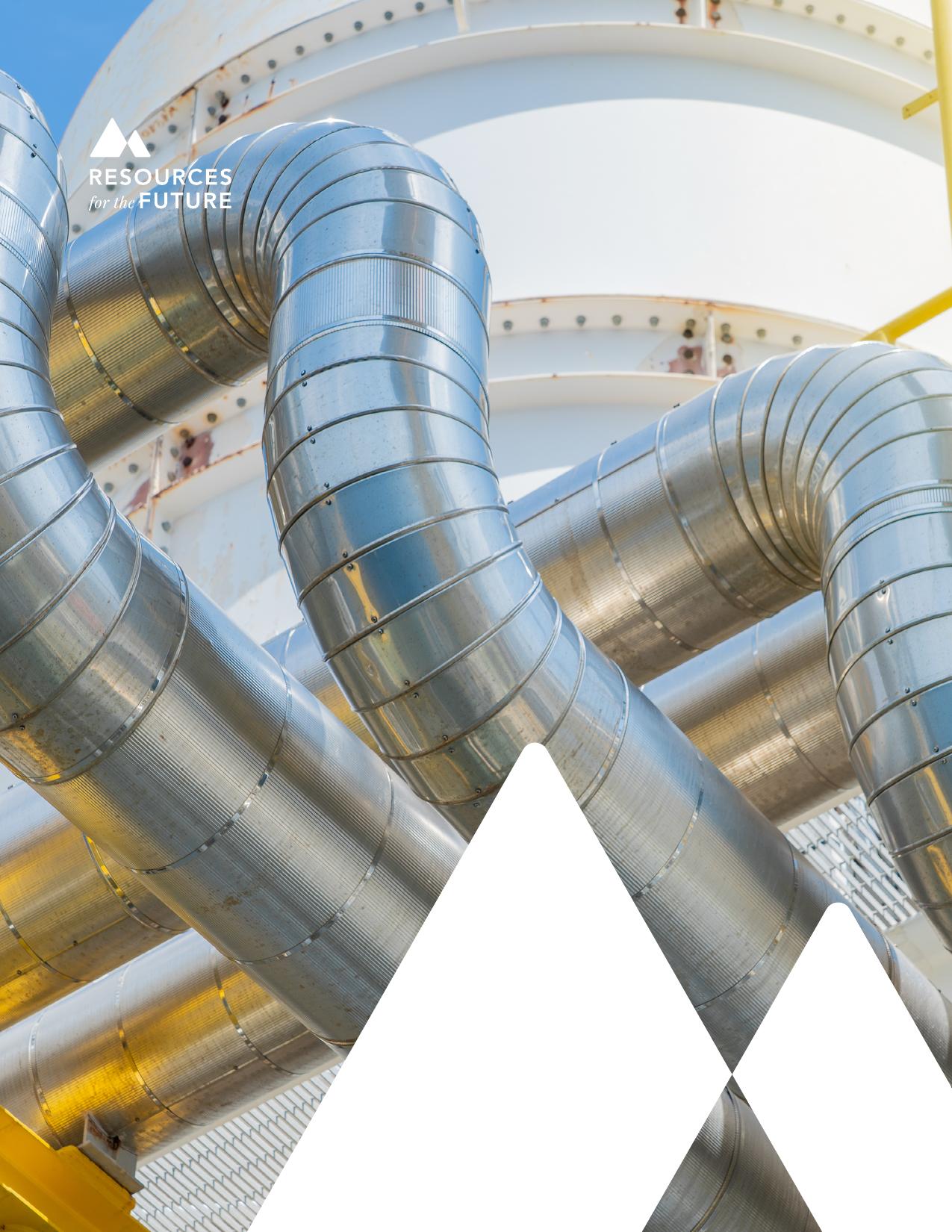IncentivesforCleanHydrogenProductionintheInflationReductionActAIncentivesforCleanHydrogenProductionintheInflationReductionActAlanKrupnickandAaronBergmanReport22-13November2022ResourcesfortheFutureiAbouttheAuthorsAlanKrupnickisaseniorfellowatResourcesfortheFutureandanexpertontheoilandgassector,reducinggreenhousegasemissionsfromthisandtheindustrialsectors,andcost-benefitanalysis.Inparticular,Krupnick’srecentresearchfocusesongreenpublicprocurement,decarbonizedhydrogenandtaxcredits,anddevelopingmarketsforgreennaturalgas.HisportfolioalsoincludesguidingthevalueofinformationagendacoveredbyourVALUABLESinitiativewithNASA,thevaluationofreducingasthmarisks,estimatingthevalueofstatisticallife,andissuesofregulatoryreform.AaronBergmanisafellowatResourcesfortheFuture.PriortojoiningRFF,hewastheLeadforMacroeconomicsandEmissionsattheEnergyInformationAdministration(EIA),managingEIA’smodelinginthoseareas.BeforeworkingatEIA,BergmanspentoveradecadeinthepolicyofficeattheDepartmentofEnergy,workingonabroadarrayofclimateandenvironmentalpolicies.BergmanhasworkedintheWhiteHouseattheOfficeofScienceandTechnologyPolicy,managingtheQuadrennialEnergyReviewandhandlingthemethanemeasurementportfolio,andattheCouncilonEnvironmentalQuality,workingoncarbonregulation.Bergmanenteredthefederalgovernmentin2009asaScienceandTechnologyPolicyFellowwiththeAmericanAssociationfortheAdvancementofScience,afterworkinginhighenergyphysics.AboutRFFResourcesfortheFuture(RFF)isanindependent,nonprofitresearchinstitutioninWashington,DC.Itsmissionistoimproveenvironmental,energy,andnaturalresourcedecisionsthroughimpartialeconomicresearchandpolicyengagement.RFFiscommittedtobeingthemostwidelytrustedsourceofresearchinsightsandpolicysolutionsleadingtoahealthyenvironmentandathrivingeconomy.TheviewsexpressedherearethoseoftheindividualauthorsandmaydifferfromthoseofotherRFFexperts,itsofficers,oritsdirectors.SharingOurWorkOurworkisavailableforsharingandadaptationunderanAttribution-NonCommercial-NoDerivatives4.0International(CCBY-NC-ND4.0)license.Youcancopyandredistributeourmaterialinanymediumorformat;youmustgiveappropriatecredit,providealinktothelicense,andindicateifchangesweremade,andyoumaynotapplyadditionalrestrictions.Youmaydosoinanyreasonablemanner,butnotinanywaythatsuggeststhelicensorendorsesyouoryouruse.Youmaynotusethematerialforcommercialpurposes.Ifyouremix,transform,orbuilduponthematerial,youmaynotdistributethemodifiedmaterial.Formoreinformation,visithttps://creativecommons.org/licenses/by-nc-nd/4.0/.IncentivesforCleanHydrogenProductionintheInflationReductionActiiContents1.Introduction�12.HydrogenProductionBackground�22.1.ProducingHydrogenfromHydrocarbons�22.2.ProducingHydrogenfromWater�43.TaxCreditChangesintheIRA�43.1.TheHydrogenTaxCredit�43.2.TheCarbonSequestrationTaxCredit�63.3.TheImplicitCarbonPrice�63.4.LifeCycleGreenhouseGasEmissions�94.TheCostsandEmissionsofHydrogenProduction�114.1.TheCostsofHydrogenProduction�124.2.TheEmissionsfromHydrogenProduction�145.TheImpactofIRATaxCreditsontheCostofHydrogen�155.1.TheValueofthePTCversustheITC�155.2.TheImpactofthePTC�165.3.PerverseIncentivesandthe45QTaxCredit�196.Sensitivities�206.1.EmissionsRateSensitivities�206.2.FuelPriceSensitivities�227.TheHydrogenEconomy�28IncentivesforCleanHydrogenProductionintheInflationReductionAct11.IntroductionCleanhydrogencanbeakeycomponenttodecarbonization,particularlyintheindustrialsector.Beyonditscurrentuseinchemicalsandrefining,hydrogenhaspotentialnewandexpandedusesin,forinstance,processheat,ironandsteel,electricitygenerationandtransportation.However,currenthydrogenproductiontechnologiesyieldsignificantcarbonemissions,andlittleeconomicincentivehasexistedtoexpandtheuseofhydrogentonewareas.Butthathasbeguntochange,withtheUSCongressrecentlyplacinglargebetsonafuturehydrogeneconomy.Lastyear’sInfrastructure,InvestmentandJobsAct(IIJA)contains$9.5billionfundingforhydrogen,including$8billionforhydrogenhubs.Andthisyear’sInflationReductionAct(IRA)containstwoprovisionsthatwillsubsidizecleanhydrogenproduction.Thefirstisanewtaxcredit(section45Vofthetaxcode)wherethevalueofthecreditisbasedonlifecycleemissions.Thesecondisasubstantialincreaseinthevalueoftheexistingtaxcreditforcarbonsequestration(section45Qofthetaxcode),whichisusedtomake“blue”hydrogen.Eachofthesetaxcreditscanreducethepricedifferencebetweencleanhydrogenandmorecarbon-intensivealternatives.Tobetterunderstandthecost-effectivenessofthesepolicies,thispricedifferencecanbeconvertedintoanimplicitcarbonprice.Aswewillsee,thevaluessoobtainedaresignificantlyhigherthanmanyestimatesofthesocialcostofcarbonandmaythusappearuneconomic.However,thegoalofthesetaxcreditsisnotsolelytocorrectforthelackofapriceoncarbonbutalsotoaidthedeploymentofnascenthydrogentechnologies.Suchdeploymentcanhavespillovereffects,disseminatingknowledgeandpotentiallyloweringcostsinthefuture,anadditionalexternalitythat,althoughdifficulttoquantify,mayjustifythehigherimplicitcarbonprices.Thesetaxcreditshavedifferentimpactsdependingontheformofhydrogenproduction.Fossil-fuelbasedproductiongenerallyusesnaturalgas(althoughitcanuseotherfuelsaswediscusslater).Thisprocessproducesgreenhousegasemissionsfromthecarbondioxidereleasedasthehydrogenisextractedfromthenaturalgas(orotherhydrocarbon).Tobecleanhydrogen,theseemissionsmustbecaptured.Ontheotherhand,electrolysis,theproductionofhydrogenfromwaterusingelectricity,producesnodirectgreenhousegasemissions.However,electrolysisconsumeslargeamountsofelectricitythatcanleadtobothhighcostsandhighlifecycleemissionsiftheelectricityispurchasedonthewholesalemarket.Costscouldbelowered,however,byusinglowercostelectricity,eitherthroughadirectconnectiontoageneratororbyonlyproducinghydrogenwhenthepriceofelectricityislow.Bothformsofhydrogenproductionarepotentiallyeligibleforthe45Vtaxcredit,buttheymustdemonstratelowlifecycleemissionstodoso,withthemagnitudeofthecreditdependingonthelevelofemissions.Inthecaseoffossil-fuelbasedproduction,beyondthedirectemissions,thelargestcomponentofthelifecycleemissionsisupstreammethaneleakage;forelectrolysis,itistheemissionsassociatedwithelectricityproduction.TheTreasuryDepartmentwillhavetoissuearegulationonhowtocalculatetheselifecycleemissions,whichwillhaveamajorimpactonthesubsidiesavailabletohydrogenproducersandthecompetitivenessofvariousformsofhydrogenproduction.ResourcesfortheFuture2Incontrasttothe45Vtaxcredit,onlyhydrogenproducersusingcarboncapture,utilizationandstorage(CCUS)areeligibleforthe45Qtaxcredit.Thistaxcreditisavailableirrespectiveofthelifecycleemissionsand,aswewillsee,canbemorevaluablethanthe45Vtaxcredit.Producersarenotallowedtotakebothtaxcredits.WewillanalyzetheimpactsofthesetaxcreditsonthecostsofhydrogenproductionusingasetofhydrogenproductionmodelsfromtheNationalRenewableEnergyLaboratory(NREL).Wewillseethatthe45Qtaxcreditissufficienttomakesomeformsoffossilfuel–basedhydrogenproductioncompetitivewithcurrenthigh-emissionproductiononalevelizedcostbasis.Thehighcostofgridelectricityandtheassociatedemissions,ontheotherhand,makeithardforelectrolysistocompete.However,electrolyzersthatsourcecleanerandcheaperelectricitycanqualifyforhighlevelsofthe45Vtaxcreditandcompetewithfossil-fuelbasedhydrogenproduction.Inthelongrun,costsforelectrolyzersareexpectedtodecrease,andthegridshouldbelesscarbonintensive,makingelectrolyzerscompetitivemorebroadly.Inthisreport,wewillreviewvariousformsofhydrogenproductionandthechangestothetaxlawmadebytheInflationReductionAct.Wewillcalculatetheimplicitcarbonpricesanddiscussthecalculationoflifecycleemissions.Next,usingtheNRELmodels,wewilldiscusstheimpactsofthetaxcreditsonthelevelizedandmarginalcostsofhydrogenproductionandseehowtheydependonupstreammethaneleakageratesandthecarbonintensityofelectricityproduction.Wewillalsoexamineindetailhowtherelativecompetitivenessofthevariousformsofproductiondependsonnaturalgasandelectricityprices.Weconcludewithadiscussionofthebroaderhydrogeneconomy.2.HydrogenProductionBackgroundThetwoprimarymeansofhydrogenproductionusehydrocarbons(i.e.,fossilfuelsorbiomass)asafeedstockorsplitwaterusingelectricitythroughelectrolysis.Productionusinghydrocarbonsusesaseriesofchemicalreactionstoreleasethehydrogen,wheretheremainingcarbonatomsareusuallyreleasedascarbondioxide.Electrolysis,ontheotherhand,hasnodirectgreenhousegasemissionsbutrequiressignificantamountsofelectricity.2.1.ProducingHydrogenfromHydrocarbonsMosthydrogenproducedgloballyisthroughsteammethanereforming(SMR)whichfallsintothefirstcategory.SMRtakesmethane,theprimarycomponentofnaturalgas,andheatsitinthepresenceofsteamtocreateamixtureofcarbonmonoxideandhydrogen:CH4+H2OCO+3H2IncentivesforCleanHydrogenProductionintheInflationReductionAct3Inadditiontoconsumingnaturalgasasafeedstock,thisreactionrequiresheatthatcanbeproducedbythecombustionofadditionalnaturalgas.Toproduceadditionalhydrogen,thereformingreactionisusuallyfollowedbyawater-gas-shiftreactionthatconvertsthecarbonmonoxidetocarbondioxideandadditionalhydrogen:CO+H2OCO2+H2Thisreactionisexothermic(i.e.,producesenergy),asopposedtotheSMRreaction,whichisendothermic(i.e.,usesenergy).Anotherhydrogenproductiontechnologyusingnaturalgasisautothermalreforming(ATR),whichmixesmethanewithoxygentoproduceheat,hydrogenandcarbonmonoxidethroughapartialoxidationreaction:2CH4+O22CO+4H2Theheatfromthisreactioncandrivethesteammethanereformingreactionabove.Theresultinggasisthenrunthroughawater-gasshiftreactiontoproducemorehydrogen.AnadvantageofATRoverSMRisthatitrequiresnoadditionalnaturalgas,asthepartialoxidationreactionprovidestheheat.ATRisnotwidelycommercialized.Hydrogenalsocanbeproducedfromcoalorbiomassthroughgasification,whichconvertsthefueltoamixtureofmostlycarbonmonoxideandhydrogengaswithsomeresidualmethaneandcarbondioxide,oftencalled“syngas.”1Afurtherwater-gas-shiftreactionproducesadditionalhydrogen.Gasifiersarecomplex,expensiveandultimatelyproducemorecarbondioxideemissionsthanSMRorATR.Inadditiontotheirdirectemissions,theseformsofhydrogenproductionhavelifecyclegreenhousegasemissionsfromupstreamfuelproduction,processinganddistribution.Theseincludethereleaseofmethanefromupstreamnaturalgasandcoalproductionandtransportationandtheemissionsassociatedwithanyelectricityused.Astraightforwardwaytolowertheemissionsfromthesetechnologiesistocapturethecarbondioxide,eitherfromtherelativelypureprocessemissionstreamorfromtheentireplant,resultingincarboncaptureofroughly55–70percentandupwardsof90percent,respectively.However,additionalenergyisrequiredtorunthecaptureequipment,partlymitigatingtheemissionsreductions.Thereareavarietyofmorenascenttechnologiestoproducehydrogenfromhydrocarbonsthatwewillnotdiscusshere.1https://netl.doe.gov/research/Coal/energy-systems/gasification/gasifipedia/intro-to-gasificationResourcesfortheFuture42.2.ProducingHydrogenfromWaterTheothermajormethodofproducinghydrogenisthroughelectrolysiswhereelectricityisusedtoseparatethehydrogenfromtheoxygeninwater:2H2O+electricity2H2+O2Whilelittlehydrogenisproducedthiswaytodaybecauseofitssignificantelectricityconsumptionandhighcost,electrolysishastheadvantageofproducingnodirectgreenhousegasemissions.Thethreemainelectrolysistechnologiesusedtodayarealkalineelectrolysis,protonexchangemembrane(PEM)electrolysisandsolidoxideelectrolysis.Thesetechnologiesdifferintheiruseofcatalysts,solutionsandinotheraspects,whilehavingthesamenetchemicalreaction.Importantly,solidoxideelectrolysis,whichhasnotyetbeencommercialized,requireshightemperaturesand,consequently,aheatsource.Othertechnologies,suchasphotoelectrochemicalwatersplitting,areunderdevelopment.2Whilethedirectgreenhousegasemissionsfromelectrolysisarezero,thelifecycleemissionscanbesignificantiftheelectricityconsumedhasahighcarbonintensity.Intheshortterm,upstreamemissionscanbereducedbyusingzero-emissionelectricity.Inthelongterm,weexpectthecarbonintensityoftheelectricgridtodecrease.TheBidenadministrationhassetagoalofazero-carbongridby2035.3.TaxCreditChangesintheIRAThetwoimportanttaxcreditsintheIRAforhydrogenarethenewtaxcreditforhydrogenproductionandtheincreaseinvalueoftheexistingcreditforcarbonsequestration.Wediscusseachoftheseprovisionsindetailinthissectionbeforeturningtotheireffectonhydrogenproduction.3.1.TheHydrogenTaxCreditTheIRAcreatesanewtaxcredit(26USC45V–45Vinwhatfollows)tosubsidizetheproductionof“clean”hydrogen.Hydrogenproducershavetheoptionofeitherreceivingacreditequaltoaspecifieddollarvalueperkilogramofhydrogenproduced(aproductiontaxcredit;PTC)orataxcreditequaltoaspecifiedfractionoftheircapitalexpenses(aninvestmenttaxcredit;ITC).Thesevaluesdependonthelifecyclegreenhousegasemissionsassociatedwiththehydrogenproductionandwhetherornotthehydrogenproducercomplieswiththeprevailingwageandapprenticeship2https://www.energy.gov/eere/fuelcells/hydrogen-production-photoelectrochemical-water-splittingIncentivesforCleanHydrogenProductionintheInflationReductionAct5requirementsinthebill.3Table1liststhevaluesforcomplyingproducers.Ifaproducerisnotincompliancewiththeserequirements,thecreditisreducedbyafactoroffive.Sincetheseprojectsmayalsobeeligiblefortax-exemptbonds,ifaprojectreceivessuchfinancing,theamountofcreditisreducedforboththeITCandPTC.InthecaseofthePTC,thetaxcreditisreceivedfor10yearsafterthefacilityisplacedintoservice.Nofacilitythatbeginsconstructionafter2032qualifies,butmodificationstofacilitiesinservicebefore2023canqualify.Nofacilitymaytakeboththe45Vandcarboncaptureandsequestrationtaxcredits.However,onecansimultaneouslytakethe45Vtaxcreditandmostoftheothertaxcreditsforcleanenergygeneration.TheIRAalsocontainsimportantprovisionstolettaxpayersmonetizethetaxcredit,allowingvarioustax-exemptentitiestoreceiveapaymentinsteadofataxcreditandallowingalltaxpayerstoreceivesuchapaymentforthePTCforthefirstfiveyears.4Inaddition,foralltaxpayers,thecreditistransferrableinreturnforcash,whichallowsmonetizationwithfewertransactioncostsascomparedtobringinginanoutsideinvestorwithtaxappetite(i.e.,apositivetaxbill).Unlikemanyothertaxcreditsinthisbill,therearenobonusesfordomesticcontentordevelopmentinenergycommunities.3TheprevailingwagerequirementisthattheconstructionofthefacilityandanysubsequentalterationorrepairmustpayworkersatleastthelocalprevailingwagesforasimilaractivityasdeterminedbytheSecretaryofLaborundertheDavis-BaconAct.Withrespecttoapprenticeship,theIRArequiresthatapprenticessupplyupto15percentofthelaborhours,dependingonthefirstyearofconstruction.Theseapplytoanyfacilityoralterationorrepairofacomponentofafacilitythatbeginsconstruction60daysaftertheSecretaryoftheTreasuryissuesregulationsontheserequirements.4Manydevelopersdonotpaytaxesinearlyyearseitherbecauseoftax-exemptstatusorbecauseofotherdeductions,suchasaccelerateddepreciation,andsocannottakeimmediateadvantageofthetaxcredit.Table1.Valuesofthe45VHydrogenInvestmentTaxCreditandProductionTaxCreditLifeCycleEmissions(kgCO2e/kgH2)ITCPercentagePTCValue(2022$/kgH2)4–2.56percent0.602.5–1.57.5percent0.751.5–0.4510percent1.000.45–030percent3.00ResourcesfortheFuture63.2.TheCarbonSequestrationTaxCreditTheIRAalsosignificantlyincreasesthelevelofthetaxcreditforcarbonoxidesequestration.ThistaxcreditwascreatedintheEnergyImprovementandExtensionActof2008andsubsequentlymodifiedbytheBipartisanBudgetAct,whichincreasedthelevelofthecredit,replacedthepriortonnagecapwithafixeddurationof12yearsandexpandedeligibilitytoincludedirectaircapturewhilesettingvariouscapturethresholdsforqualificationdependingonthetypeoffacility.Inaddition,theBipartisanBudgetActaddedcarbonmonoxideasaneligiblegas,exceptinthecaseofdirectaircapture.WithmanyinindustryarguingthattheseincentivesweretoosmalltofosterwidespreaduseofCCUS,theIRAfurtherincreasedthelevelofthecreditforfacilitiesbuiltafterthepassageoftheBipartisanBudgetActtoaflat$85/tonneforsequesteredcarbondioxideand$60/tonneforutilizedcarbondioxide,includingforEOR,replacingthelinearlyrisingscaleintheBipartisanBudgetAct.5Inaddition,directaircaptureisgivenacreditof$180/tonneand$130/tonneforsequesteredandutilizedcarbon,respectively.However,muchlikeinthe45Vtaxcredit,thesevaluesaredividedbyfiveifprevailingwageandapprenticeshiprequirementsarenotmet.TheIRAalsochangestheeligibilityrequirementsasfollows:•Adirectaircapturefacilitymustcaptureatleast1,000metrictonnesperyear.•Anelectricgeneratormustcaptureatleast18,750metrictonnesperyearandhaveadesignedcapturerateofatleast75percentwithrespecttoabaseline.•Anyotherfacilitymustcaptureatleast12,500metrictonnesperyear.Thesamereductionsfortax-exemptbondsasforthe45VPTCandthesameprovisionsthatallowdirectpaymentsalsoapplytothe45Qcredit.3.3.TheImplicitCarbonPriceThesesubsidiesreducethepricedifferencebetweencleanhydrogenandadirtieralternative.Theydosobydecreasingthepriceofthecleanenergy,incontrasttoacarbontax,whichincreasesthepriceofmorecarbon-intensiveenergy.Inthisway,onecanconvertthesubsidyintoanequivalentcarbonpriceasfollows.AssumewehaveadirtysourceofenergywithemissionsYd,andacleanenergysourcewithemissionsYc.Iftheper-unitsubsidyforcleaniss,thentofindtheequivalenttax,t,weneedtosolves=t(Yd-Yc)5Thesevaluesarenominaluntil2026andthenrisewithinflation.IncentivesforCleanHydrogenProductionintheInflationReductionAct7Thiscanberearrangedtogivet=s/(Yd-Yc),whichistheper-unitsubsidycostdividedbytheper-unitabatement.Whilewewillreportimpliedcarbonpricesinanumberofabatementscenarios,thesearenotmeasuresoftheabatementcostinthosescenarios.Instead,iftheactualabatementcostislowerthantheimpliedcarbonprice,thenitiseconomicforthechangetooccur.Inthiscase,theimpliedcarbonpriceisakindofmeasureofthecost-effectivenessofthepolicy.Tocalculatetheimplicitcarbonpriceforcurrentusesofhydrogen,wecancomparewithexistinghydrogenproduction,whichisnearlyalwaysanSMRprocess.Thishasalifecycleemissionsrateofroughly11.2kgCO2e/kgH2inthesemodels.ComparingwiththeemissionsratesinTable1givesimplicitcarbonpricesrangingfrom$84/tonneforhydrogenwithanemissionsrateof4kgCO2e/kgH2to$280/tonneforhydrogenwithanemissionsrateof0.45kgCO2e/kgH2.Inotherenduses,hydrogenmaybecompetingwithfuelssuchasnaturalgasinprocessheatormotorgasolineordieselfuelintransportation.Thecorrectunitstousearetheenergyservicesprovided.Forprocessheat,theimportantquantityisthepricetodeliveraJouleofheat.6Fornaturalgas,thissubsidyislargerthanforexistinghydrogenproduction,rangingfrom$134/tonneCO2eforhydrogenwithanemissionsrateof4kgCO2e/kgH2to$374/tonneCO2eforhydrogenwithanemissionsrateof0.45kgCO2e/kgH2.Fortransportation,thecorrectunitwilldependontheenduse.Forfreight,thisislikelyton-miles.Whilewedonothavedatafortheefficiencyofhydrogeninthatcontext,wecanlookatitsuseinpassengerfuelcellvehicles,wheretheappropriateunitisvehiclemilestraveled.The2022ToyotaMiraihasafuelefficiencyof72milesperkgH2.7Wecomparewithagasolinefueledcarthatachieves25mpg.Thisleadstoanimplicitcarbonpriceof$28–121/tonne.Foracarat55mpg,theimplicitcarbonpriceswillmorethandouble.Notethatthisdoesnotmeanthatthesubsidyismorelikelytoleadtoabatementinthatscenarioastheabatementcostindollarspertonnewillalsoincreasebecausetherearefeweremissionstobeabated.Figure1showsallofthesevalues.6Thiscalculationignoresthatdifferentfuelscandeliverdifferentheatquality,suchasvaryingtemperature.7https://www.fueleconomy.gov/feg/fcv_sbs.shtmlResourcesfortheFuture8Unlikeacarbontax,whereeachtonneofgreenhousegasesemittedistaxed,the45Qpolicyinsteadsubsidizestheamountofsequesteredorutilizedemissions.Thus,whencomparingthepricedifferencebetweenthesameformofproductionwithandwithoutCCS,theimplicitcarbontaxisexactlythevalueofthesubsidy,whichis$85/tonneforsequesteredcarbondioxide.However,ifweinsteadcomparetonaturalgasusedforprocessheat(usingunitsofJoules),thatsubsidyincreasesto$169/tonne.Atthehighendoftheseranges,thevaluesarehigherthantheUSgovernment’sofficialof$51/tonne.TheyarealsohigherthanRFF’srecentlypublishedcentralvalueof$185/tonnealthoughnotmarkedlyso,andwellwithinthe95percentconfidenceintervalsandinlinewithhigherestimatesintheliterature.8Thismeansthat,evaluatedpurelyonthebasisofthebenefitsofthesepolicieswithrespecttocarbonabatement,theymaylookoverlyexpensive.However,asnotedabove,animportantexternalityexistsbeyondclimatechange:thepotentialspilloversfromtechnologydemonstrationanddeployment.Whilesuchanexternalityisextremelydifficulttoquantify,thelargersubsidiesherecouldpotentiallybejustifiedinthebroadercontextoftryingtocreateacleanhydrogeneconomy,aswediscusslater.8https://www.nature.com/articles/s41467-021-24487-wFigure1.ImplicitCarbonTaxfor45VTaxCreditbyEndUseIncentivesforCleanHydrogenProductionintheInflationReductionAct93.4.LifeCycleGreenhouseGasEmissionsSincethevalueofthe45Vtaxcreditvariessignificantlydependingonthelifecycleemissions,howthisisdefinedhasverylargeimplicationsforthepotentialcompetitivenessofdifferentmeansofhydrogenproduction.Thiscanbeacomplexarea,sowequotetherelevantIRAprovisions(section13204):“(1)LIFECYCLEGREENHOUSEGASEMISSIONS.—(A)INGENERAL.—Subjecttosubparagraph(B),theterm‘lifecyclegreenhousegasemissions’hasthesamemeaninggivensuchtermundersubparagraph(H)ofsection211(o)(1)oftheCleanAirAct(42U.S.C.7545(o)(1)),asineffectonthedateofenactmentofthissection.(B)GREETMODEL.—Theterm‘lifecyclegreenhousegasemissions’shallonlyincludeemissionsthroughthepointofproduction(well-to-gate),asdeterminedunderthemostrecentGreenhousegases,RegulatedEmissions,andEnergyuseinTransportationmodel(commonlyreferredtoasthe‘GREETmodel’)developedbyArgonneNationalLaboratory,orasuccessormodel(asdeterminedbytheSecretary).”Section211(o)(1)oftheCleanAirActreferstotheRenewableFuelStandard(RFS):“Theterm‘lifecyclegreenhousegasemissions’meanstheaggregatequantityofgreenhousegasemissions(includingdirectemissionsandsignificantindirectemissionssuchassignificantemissionsfromlandusechanges),asdeterminedbytheAdministrator,relatedtothefullfuellifecycle,includingallstagesoffuelandfeedstockproductionanddistribution,fromfeedstockgenerationorextractionthroughthedistributionanddeliveryanduseofthefinishedfueltotheultimateconsumer,wherethemassvaluesforallgreenhousegasesareadjustedtoaccountfortheirrelativeglobalwarmingpotential.”Thisleavesanumberofissuesunresolved.WhiletheEPAhasissuedmanyrulemakingsondeterminingthelifecycleemissionsforvariousfuelsundertheRFS,theIRAgivestheSecretaryofTreasurydirectiontoissueitsownregulationsondetermininglifecyclegreenhousegasemissionswithinoneyearaftertheenactmentoftheAct.Animportantpointnotaddressedisthattheglobalwarmingpotential(GWP)forgases(theamountofforcingrelativetocarbondioxide)variesdependsontherelevanttimescale.Forexample,duetoitsrelativelyshortlifetimeintheatmospherebeforeitisconvertedintocarbondioxide,methane’sGWPisroughly2.7timeslargerovera20-yeartimescaleasopposedtoa100-yeartimescale.EPAusestheonehundredyearGWPinitscalculations,butitisnotcleariftheTreasurywouldabidebythatstandard.Inaddition,GWPscanvaryasourunderstandingofthescienceevolves,sotheSecretarywouldneedtochooseaparticularvintage.Thisappliesinparticulartohydrogen,itselfanindirectgreenhousegas,whichisnotoneofthestandardKyotogasesusuallyconsideredandwhereitsGWPisstillbeingdebated.ResourcesfortheFuture10Anotherimportantquestionisthemeaningofparagraph(B)inthefirstquotationabove.ItappearstosaythattheGREETmodelmustbeusedtodeterminethescopeofthelifecycleemissionscalculationbutnotnecessarilythecoefficients.Wehavenotbeenabletofindtheterm“well-to-gate”usedwithrespecttotheGREETmodel.Themostlikelyreferenceis“well-to-pump”emissions(asopposedto“well-to-wheels”),whichincludesalltheupstreamdirectemissionsusedtogeneratethefuel.Forexample,forelectricity,thiswouldincludeboththeemissionsatthepointofgenerationandanyupstreamemissionsresultingfromtheproductionandtransportationofthefuelsconsumedbutnotanyembodiedemissionsintheinfrastructureusedtogeneratetheelectricity.Similarly,thiswouldincludemethaneleakagefromnaturalgasproductionandtransportation.ThisisconsistentwithDOE’sdefinitionofwell-to-gategivenintheFundingOpportunityAnnouncementfortheH2Hubs.9ItisimportantthattheSecretaryoftheTreasury,whenissuingtheseregulations,giveshydrogenproducerstheoptiontopurchasefuelsthathaveloweremissionsratesthanthenationalorregionalaverages.Forexample,aconsumerofnaturalgascouldchoosetopurchasefromaproviderthathaslowleakagerates,withtheSecretaryimposingamonitoringandverificationrequirement.Similarly,forelectricity,aconsumershouldbeabletodemonstratetheconsumptionofelectricitycleanerthanthatdirectlypurchasedfromthegrid.Thisismorechallengingthanwithnaturalgas,however,because,withoutadirectconnectionbetweenanelectricitygeneratorandtheuserofitspower,onecannotsaythatanyparticularconsumerofelectricityisconsumingfromaparticularsourceofgeneration.TheseissuesarediscussedindetailinanRFFblogpost.TheSecretary’sdecisionsonquantificationoflifecycleemissionswillhaveimportantimplicationsfortheabilityofvarioustechnologiestotakeadvantageofthe45Vtaxcredit.Itslargesubsidiesareonlyavailabletoproducersthathaveminimalmethaneleakageoverthelifecycleanduseextremelycleanelectricity.Itcanbeverychallengingtomeetthoseconditions.TheSecretarywillhavetobalancethedesiretoenablethesetechnologiestoreceivethehigherlevelsofsubsidywiththeneedtoensurethatthecarbonreductionsassociatedwiththeirusearenotreducedorwashedoutbyanincreaseinelectricityornaturalgasconsumptionwithhighlifecycleemissions.9“Inthissolicitation,theterm‘well-to-gate’emissionsreferstothoseassociatedwithfeedstockextraction(e.g.,naturalgasdrilling),generationofelectricity(usedinnumerousstepsassociatedwithhydrogenproduction),feedstockdelivery(e.g.,naturalgascompression,naturalgasleakage),hydrogenproduction(e.g.,reforming,electrolysis,gasification,pyrolysis),anddeliveryandsequestrationofCO2(e.g.,fuelcombustionforcompression,leakage).Thedefinitionofthistermisconsistentwiththeterm‘well-to-gate’and‘lifecycle’inSection45V‘CreditforProductionofCleanHydrogen’intheInflationReductionAct.”IncentivesforCleanHydrogenProductionintheInflationReductionAct114.TheCostsandEmissionsofHydrogenProductionInthissection,wewillquantifythecostsandtheemissionsofvarioushydrogenproductiontechnologiesusingasetofmodelsproducedbytheNationalRenewableEnergyLaboratory(NREL).10Forcosts,theprimarymetricweuseisthelevelizedcostofhydrogen(LCOH),whichistheconstantpricethataprovidermustsellatoverthelifetimeoftheplanttorecoverallcapitalcosts,givenspecifiedfundingassumptions.Asecondmetriciswhetherahydrogenproducercansellthehydrogenataprofit.Thiswilldependonthemarginalcostofproduction(i.e.,thecosttoproduceasingleunitofhydrogen).Aproviderwithalowermarginalcostwillbeabletomakeaprofitatalowersaleprice.However,thismetricdoesnotguaranteethattheprofitswillbesufficienttorecovercapitalandfixedcosts.Welookbothatthedirectandlifecycleemissionsassociatedwithhydrogenproductionforeachtechnologyusingcurrentvaluesforthegridcarbonintensityandupstreammethaneleakage.TheNRELmodelsprovideaconsistentsetoffinancingassumptionstocompareacrosstechnologies,althoughotherreasonableassumptionscanbemade.Importantly,alltechnologiesassumea40-yearlifetimeandan8percentinternalrateofreturnwitha60/40debt/equitysplitusingrevolvingdebtat3.7percentpaidoffattheendoftheplant’slifetime.ThetechnologiesweexamineareanSMRwithoutcarboncapture,anSMRwith96percentcapture,anATRwith94percentcapture,andaPEMelectrolyzer.11CapturingonlytheprocessemissionsfromanSMR(whichwouldprovidefrom60-66%emissionsreduction)isnotanoptioninNREL’smodels.Forthisanalysis,wegenerallyassumetechnologieshaveahighcapacityfactor,reflectingtheneedofmostendusesforasteadystreamofhydrogen.However,wealsomodelaPEMelectrolyzerwithapowerpurchaseagreement(PPA)fromawindfarmwithacapacityfactorof30percent.Thistechnologydemonstratestheuseofcleanpowerbymatchingtheoutputhourbyhourwithaspecificrenewableenergygeneratorandpayingforthatelectricitydirectly,bypassingwholesaleelectricitymarkets.RenewablePPAstypicallyarepricedwellbelowwholesaleelectricityprices.Thisisarelativelyrigorousmeanstodemonstratetheconsumptionofcleanpower,whichwillmostlikelybeallowedundertheregulations.Onecouldaddthecostofstorageandtransportationtoachieveasteadystreamofhydrogen,butwehavenotdoneso,asthosecostsarenotprovidedintheNRELmodels.Anotherpossibilityis10https://www.nrel.gov/hydrogen/h2a-production-models.html11TheNRELmodelsuitealsoincludesasolidoxideelectrolyzer.However,thistechnologyrequireshighheat,whichNRELassumescomesfromnaturalgascombustion.Theassociatedemissionsmakeitverydifficultforthetechnologytoreceiveataxcredit,and,consequently,itisuncompetitiveinallthescenariosweconsider.Amorereasonableassumptionmaybethattheheatcomesfromacarbonfreesource,butthatdataisnotavailable.Assuch,wedonotincludethistechnologyinouranalysis.ResourcesfortheFuture12thatageneratorcouldpurchaseelectricityfromthegridwhentherenewablegeneratorisnotproducing.Wewillbrieflydiscussthislater.4.1.TheCostsofHydrogenProductionFigure2showsthecomponentsoftheLCOHforeachtechnology.Forthenaturalgas–basedtechnologies(SMRandATR),theadditionofCCSincreasescapitalcostsandotherfixedcostsandoperatingandmaintenancecosts.ThetransportationandstoragecostsforthecarbondioxideareincludedintheOtherVariableCostscategory.Fuelcostsrepresentthemajorityofthecostsformosttechnologies,exceptforSMRwithCCSandPEMwithPPA.ForPEM,inparticular,thecostofelectricityisbyfarthelargestcomponentoftheLCOH.Thisunderlinestheneedtofindlow-costelectricitytomakeelectrolyzerseconomic.InthePEMwithPPAtechnology,costsarereducedbypurchasingelectricityfromawindfarm,butthelowercapacityfactorincreasesthelevelizedcostofcapital.Cheaperelectricitycouldalsocome,forexample,byusingelectrolyzersonlywhenthemarginalcostofelectricityisextremelyloworzero,suchaswhenwindandsolarenergyarethemarginalproducers.However,thisstrategywouldalsolowerthecapacityfactor,increasingthecapitalcomponentoftheLCOH.Naturalgas–basedtechnologiesandelectrolyzersneedaroughly$1/kgH2or$4decrease,respectively,inlevelizedcosttobecompetitivewithcurrentSMRproduction.However,fortheelectrolyzerwithaPPA,thatisreducedto$2/kgH2duetothelowelectricitycostsfromthePPA.Figure2.LCOHComponentsbyTechnologyIncentivesforCleanHydrogenProductionintheInflationReductionAct13Incontrastwiththelevelizedcost,themarginalcostofhydrogenproductionistheminimumpricethataproducermustsellhydrogentomakeaprofit.ThismetricignorescapitalcostsandisshowninFigure3.Itincludesallthevariablecosts(i.e.,coststhatscaleasafunctionoftheamountofhydrogenproduced)fromFigure2.Becausethecapitalcostsarenotincluded,thepremiaascomparedtoexistingSMRproductionarereducedbutstillsignificant,especiallyforelectrolysiswithahighelectricityprice.ForthePEMwithaPPA,themarginalcostisquitelowbecauseweareneglectingtheincreaseinlevelizedcapitalcostsduetothelowcapacityfactor.However,themarginalpricemaybeinfiniteifthewindisnotblowing.Thesecalculationsembedanumberofassumptions.First,asnoted,otherthanPEMwithPPA,theseareallassumedtohaveahighcapacityfactor:90percentforthenaturalgastechnologiesand97percentforPEM.Second,fuelpricesarebasedonAEO2017andarelevelizedacrossthelifetimeoftheplantgiving$5.16/MMBTUfornaturalgasand$74/MWhforelectricity,exceptforthePPApriceof$20/MWhforPEMwithaPPA.ThisPPApriceisonthelowendofpricesintheLand-BasedWindMarketReportandmaynotbeavailablenearthedesiredenduse.1212https://emp.lbl.gov/sites/default/files/2022_land_based_wind_market_report.pdfFigure3.MarginalCostComponentsbyTechnologyResourcesfortheFuture144.2.TheEmissionsfromHydrogenProductionFigures4and5showthedirectcarbondioxideemissionsforeachtechnologynotedinFigure3,andtheindirectemissions,assumingcurrentmethaneleakagevalues,respectively.Figure4.DirectCarbonDioxideEmissionsbyTechnologyFigure5.TotalLifeCycleEmissionsbyTechnologyIncentivesforCleanHydrogenProductionintheInflationReductionAct15Thesecalculationsassumeamethanecontentof90percentinnaturalgasonamolarbasis,amethaneleakagerateof2.2percent,asperAlvarezetal.13(excludingleakagefromlocaldistribution),andacarbonintensityofthegridof0.39kgCO2/kWh.Usinganaturalgasconsumptionrateforelectricityproductionof2.7scf/kWh,thisaddsanadditional0.047kgCO2e/kWhfrommethaneleakageassociatedwiththeburningofnaturalgastogenerateelectricity.Finally,Whitakeretal.14givesemissionsof0.071kgCO2e/kWhofcoalgenerationresultingfromcoalbedmethaneemissions.Usingthe2021valueof22.3percentcoalgeneration,combiningallthreevaluesgivesatotallifecyclegreenhousegasintensityofthegridof0.44kgCO2e/kWh.5.TheImpactofIRATaxCreditsontheCostofHydrogenNext,weturntotheimpactofthetaxcreditsonthecostofhydrogen.Hydrogenproducerscantakeeitherthe45Vtaxcredit(ITCorPTCversion)orthe45Qtaxcredit.WewillseethatthePTCisalmostalwaysmorevaluablethantheITC.Then,wewillshowtheimpactofthemostvaluablePTC(45Qor45V)onthelevelizedandmarginalcostofhydrogen.Sincethe45Vtaxcreditdependsonthelifecycleemissions,weexaminefourscenarioswithrespecttogridemissionsandupstreammethaneleakage.Thetwomethaneleakagescenariosarethecurrentleakagefractionof2.2percent,ascalculatedinAlvarezetal.(2018),andamoreaggressivescenarioof0.3percent,similartothe2020OneFuturereportedvalue(their2021reportedvaluewas0.424percent).15Thetwogridintensityscenariosarethecurrentemissionsintensityofthegridandacarbon-freegrid.Thelattercaneitherbethoughtofasatruezero-carbongrid,suchasintheUS2035goal,orthroughahydrogenproducerdemonstratingtheuseofzero-carbonpowerasprescribedbytheTreasuryDepartment.Inthesescenarios,weassumethatthemethaneleakageratesfornaturalgasconsumedbythehydrogenproducerandconsumedbytheelectricsectorarenotlinked.5.1.TheValueofthePTCversustheITCThechoiceofthePTCorITCisatrade-offbetweenrevenuesfromthesaleofhydrogenandareductionincapitalexpenditures.Atafixeddiscountrate(8percent),thecapacityfactoristhefundamentalvariabledeterminingthechoicebecausethatdeterminestheamountofproductionperunitofcapacity.Figure6showsthetrade-off.13https://www.science.org/doi/epdf/10.1126/science.aar720414https://onlinelibrary.wiley.com/doi/pdf/10.1111/j.1530-9290.2012.00465.x15https://onefuture.us/2020-methane-emissions-intensity-report/ResourcesfortheFuture16Thischoicedoesnotdependontheleveloflifecycleemissions,becausetheITCpercentageandthePTCvaluealwayshavethesameratio.Thefossil-fueltechnologieshavenobenefittoalowcapacityfactor,sotheywillalwayschoosethePTC.Fortheelectrolyzer,whichcanreduceemissionsbyonlyrunningwhenithasaccesstocleanelectricity,thebreakevencapacityfactoris~30percent.Infact,thePEMwithPPAtechnologyweexamineliesalmostexactlyonthePTC/ITCboundary.WeassumethatalltechnologiestakethePTCinwhatfollows.5.2.TheImpactofthePTCTheimpactofthetwosubsidiescouldoccurinatleasttwoways,dependingonhowtheproducerpricesthehydrogen.Thefirstistoassumethattheproductioncreditissimplyanotherrevenuestreamtobelevelizedoverthelifetimeoftheplantandthendeterminethefixedpriceofhydrogensuchthattheproducerrecoversallofitscostsoverthattime.Inthisway,thecostofhydrogenisdecreasedbythelevelizedcostofthesubsidy.ThesecondistoassumethattheproducerwilllowerpricesbythefullamountofthesubsidyintheyearsthatitisavailableandthenincreasepricestotheunsubsidizedLCOHsubsequently.Whilethefirstmayseemmoreconsistent,wewillfocusonthesecondbecause,afterthe10or12yearsthatthesubsidylasts,thereislikelytobeafurthercarbonpolicytorenderthehydrogenproductioncompetitive.Whenlookingatthemarginalcostofproduction,thefullsubsidyfiguresin,regardless.Tocalculatethelevelizedsubsidy,onecanmultiplyby56percentfora10-yearsubsidyand63percentfora12-yearsubsidy.Figure7showstheLCOHnetofthemostvaluablesubsidyforeachtechnologyineachscenario.Table2showsthelifecycleemissionsperkgH2produced.TheheightoftheblackbaristheLCOHlessthevalueofthesubsidy,andthecombinedheightofthetwobarsistheoriginalLCOH.Thecoloroftheadditionalbarshowswhichisthelargersubsidy.Figure6.DiscountedPTCversusITCValueIncentivesforCleanHydrogenProductionintheInflationReductionAct17Wecandrawanumberoflessonsfromthischart.First,the45QtaxcreditisoftenofgreatervaluebecausetheupstreammethaneemissionsfromtheSMRandtheATRresultinasufficientlyhighemissionrate(seeFigure7andTable2)tonotbeabletoreceivethehighervaluesofthe45Vtaxcredit.Nonetheless,the45QtaxcreditissufficienttomakebothSMRwithCCSandATRwithCCScompetitiveinpricewithcurrenthydrogenproductionviaSMRwithoutCCS.Withrespecttoelectrolysis,itcurrentlyrequiresverylowelectricity-associatedupstreamemissionstoqualifyforahighertierof45Vtaxcredit,andevenwiththatcredit,itremainssignificantlymoreexpensivethanSMR-basedproduction.WhenpairedwithaPPAforzero-carbonpower,thenetLCOHiswellbelowtheothertechnologies,withavalueof$0.02/kgH2.Figure8showsthemarginalcostsofproduction,againnetofthemostvaluablesubsidy.Thesamegeneralstoryholdsformosttechnologies:the45Qor45Vcreditisenoughtorenderthenaturalgas–basedtechnologieslessexpensivethananSMRwithoutCCS.ThePEMwithaPPA,however,hasanegativemarginalcost,makingitsignificantlycheaperonamarginalcostbasis.16Whilethispriceadvantagemightbeattractivetooff-takers,recallthatthistechnologyhasa30percentcapacityfactor,whichwouldmakeitlessamenabletoendusersthatrequireasteadystreamofhydrogenwithoutinvestmentinstorage.16Forthistechnology,duetochallengeswithstackedcolumncharts,theheightofthegreenbaristheoriginalLCOHandthebottomoftheblackbaristhenetmarginalcost.Incontrasttotheothertechnologies,thecombinedheightofthetwobarsisthetotalsubsidy.Figure7.LCOHSubsidies’ImpactbyTechnologyResourcesfortheFuture18Undertheseassumptions,the45Qtaxcreditcanrenderthenaturalgas–basedtechnologiescompetitivewithSMRproduction.WithoutaPPA,however,itisdifficultforelectrolyzerstobecompetitiveatcurrentelectricitycosts.Theneedforasteadystreamofhydrogenwillbeanimportantpartoftheirabilitytocompeteintheshortrun.Thesenumbersshouldnotbeoverinterpreted,however,astheyonlyrepresentFigure8.LCOHSubsidies’ImpactbyTechnologyTable2.EmissionsRatesforHydrogenProductionbyTechnologykgCO2e/kgH2SMRwithoutCCSSMRwithCCSATRwithCCSPEMElectrolysisPEMwithPPACurrentGridIntensity2.2percentleakage11.22.93.824.20.00.3percentleakage9.71.32.324.20.0Zero-EmissionGrid2.2percentleakage11.12.22.20.00.00.3percentleakage9.60.60.70.00.0IncentivesforCleanHydrogenProductionintheInflationReductionAct19asnapshotintime.TheLCOHdependsoncapitalcosts,whichwilllikelydeclineasnewtechnologiesdescendthelearningcurve,andtheLCOHandmarginalcostsbothdependonthepricesofelectricityandnaturalgasoverthelifetimeoftheplant,whichareuncertainandcanvarysignificantly.Particularlyforelectrolyzers,capitalcostsmaydeclinesubstantially,andthepriceofelectricitymaygodownasaresultofsubsidiesandthedecliningcostsofrenewableenergy.Asnotedabove,thesecalculationsarebasedonNREL’shydrogenproductionmodels,whichweusedfortheirconsistentsetofassumptions.However,manyotherplantconfigurationsexistthatwouldpotentiallyleadtodifferentoutcomes.5.3.PerverseIncentivesandthe45QTaxCreditThe45Qtaxcreditcancreatesomeperverseincentives.Insteadofrewardingtheamountofemissionsreduced,itrewardstheamountofcarbonstoredintheground.Comparedtoacarbontax,whichpenalizesbasedontheamountofemissionsreleasedintotheatmosphere,the45Qsubsidycouldgivealargerincentivetoatechnologythatcapturesmorecarbondioxide,eveniftheultimateemissionsratesareidentical.Toseethatthiscanhappeninhydrogenproduction,wecancomparenaturalgas–basedproductionwithcoalgasification(alsooneofNREL’smodels).Figure9showstheimpactofthe45Qtaxcreditforthesetechnologiesandtheassociateddirectemissions.Thesubsidyforcoalgasificationtechnologyisroughlydoublethatfornaturalgas–basedtechnologiesbecauseofthelargeamountofcarbondioxidecaptured.Withtheseprices,coalgasificationisnotcompetitivewithSMRorATR,butitwouldnottakeanenormousshiftintherelativepriceofnaturalgasandcoaltochangethat.However,lookingatthedirectemissions(thesecondpanel),coalgasificationisthehighestemitterofthethreelow-carbontechnologies.Figure9.The45QSubsidy’sImpactonFossil-FuelTechnologiesResourcesfortheFuture206.SensitivitiesTheseresultsdependbothontheupstreamemissionsrates,whichaffectthelevelofthe45Vtaxcreditandtheelectricityandnaturalgasprices.Inthissection,wewillshowthethresholdsforthedifferentlevelsofthe45Vtaxcreditforthenaturalgastechnologiesasafunctionofupstreamemissionsrates(i.e.,methaneleakageratesandthegridgreenhousegasintensity).Fortheelectrolyzers,wewillexamineascenariowhereaconstantstreamofhydrogenisproducedbyblendingzero-emissionintermittentpowerwithpowerpurchasedfromthegrid.Thesubsidywillbeafunctionofthepercentofcleanpowerandthecarbonintensityoftheremainingpowerused.Next,wewilllookathowtheLCOHdependsonthepriceofelectricityandnaturalgas.Wewillfirstshowthebreakevencurvesbetweenvariouspairsoftechnologiesintheabsencesofasubsidyandthenwiththeinclusionofthesubsidy.6.1.EmissionsRateSensitivitiesFigure11showsthethresholdsforeachlevelofthe45Vsubsidyforthenaturalgas–basedtechnologies.ThefirstpanelshowsthattheSMRwithCCSalreadyqualifiesforthe$0.60/kgH2subsidyandwouldneedleakageratesofroughly1.6and0.6percenttoqualifyforthenexttwohigherlevelsofsubsidy($0.75/kgH2and$1/kgH2)atthecurrentgridemissionsintensityofabout0.44kgCO2e/kWh.Forcomparison,the45Qsubsidyis$0.82/kgH2irrespectiveoftheserates.Becauseofitshigherelectricityconsumption,theslopesofthethresholdcurvesfortheATRwithCCStechnologyarelessnegative.TheATRcurrentlyisrightonthebordertoqualifyforthesmallest45Vsubsidy.Itwouldqualifyforthe$0.75/kgH2levelFigure10.DirectCarbonDioxideEmissionsIncentivesforCleanHydrogenProductionintheInflationReductionAct21ataleakagerateofroughly0.6percent,whichismuchmorestringentthantheleakagerateneededforSMR/CCStoreceivethatlevelofsubsidy.Becauseitcaptureslesscarbondioxide,fortheATR,the45Qsubsidyis$0.74/kgH2.ForthePEMtechnologies,becausetheydonotconsumenaturalgas,thelevelofsubsidyonlydependsonthegridemissionsintensity.WhileweonlymodelthePEMwithPPAata30percentcapacityfactor,onecouldimagineahydrogenproducerusingthezero-emissionenergyfromthePPAwhenavailableandpurchasingfromthegridatFigure11.DiscountedPTCversusITCValuePanelA.SMRwithCCSBreakevensPanelB.ATRwithCCSBreakevensResourcesfortheFuture22allothertimestoobtainasteadystreamofhydrogen.Figure12showsthethresholdsforthevariouslevelofsubsidiesasafunctionofthePPAcapacityfactorandgridemissionsrate.ThethresholdgridemissionsratesforthepurePEMtechnologyareatthey-interceptsofeachcurve.Duetothehighlevelsofelectricityconsumption,verycleanelectricityisneededtoqualifyforthe45Vtaxcreditatanylevel.Thisremainstrueatthe30percentcapacityfactorassumedforthePPA.Atthecurrentgridintensityofroughly0.44kgCO2e/kWh,toproducehydrogenallthetime,theelectrolyzerneedsgreaterthan84percentzero-emissionenergytoreceiveanysubsidyunder45V.6.2.FuelPriceSensitivitiesNext,weexaminefuelpricesensitivitiesbyconstructingbreakevencurvesfortheLCOHofvarioustechnologiesasafunctionofelectricityandnaturalgasprices.ThesecurvesshowthesetofpricesforwhichtheLCOHofonetechnologyequalsthatofanother.Wewillshowdifferentbreakevencurvesforthefouremissionsscenariosusedabove:2.2percentand0.3percentleakageanda0.44kgCO2e/kWhandzero-emissiongrid.Certainscenarioshaveidenticalbreakevencurves,soonlytherelevantsubsetisshown.Ourfirstcasecomparesnaturalgasandsolartechnologiesintheabsenceofanysubsidy.WedonotexaminenaturalgastechnologieswithandwithoutCCS,asnopricesexistwheretheLCOHsofthetechnologiesarelower.Figure13showsthebreakevencurvecomparingthePEMtechnologywithanSMRwithCCSandanATRwithCCS.Figure12.PEMSubsidyBreakevensIncentivesforCleanHydrogenProductionintheInflationReductionAct23The“x”isthemodeledvaluesofelectricity(ontheYaxis)andnaturalgasprices(ontheXaxis).Foranypointabovethecurve,thenaturalgas–basedtechnologyischeaperthanPEM.Thisshowsthat,absentanysubsidy,itwouldtakeextremelylowelectricityprices(below$18–$24/MWhatagaspriceof~$5/MMBTU)tomakePEMcompetitivewiththefossil-fueltechnologies,evenwithCCS.Highernaturalgaspricesallowthebreakevenelectricitypricetobesomewhathigher.Later,wewillseehowsubsidiesimpactthesecurves.WhilethePEMwithPPA(notshown)isclosertobeingcompetitive,itstillhasahigherLCOHthantheSMRwithCCS.Next,weseehowthecompetitionbetweentechnologiesisimpactedbythesubsidies.First,wecompareSMRandtheCCStechnologies,accountingfor45Qand45Vsubsidies.FortheSMRwithCCScomparison,thelevelofthesubsidyonlydependsonthemethaneleakagerate.FortheATRwithCCS,thegreaterelectricityconsumptionmeansthatthelowmethaneleakagelevelcombinedwiththecurrentgridintensityisnotsufficienttoobtainthe$1/kgH245Vtaxcredit,sothatbreakevencurveisthesameasthelineforthehighleakagerate.ForthePEM,thesubsidydependsonlyonthecarbonintensityofthegrid.ThisissettozeroforPEMwithPPA,soweonlyshowonecurvethere.InFigure14,atlowleakagerates,thesubsidizedSMRwithCCShasalowerLCOHthananSMR.Slightlyhigherelectricitypricesornaturalgaspriceswouldchangethat,however.Atahigherleakagerate,theSMRwithCCSdoesnotreceivethelarger45Vsubsidy,andthe45QsubsidyislowenoughthattheLCOHsofthetwotechnologiesareonlyequalwhenonefuelpriceisnegative,sothecurveisnotshown.FortheATRwithCCS(Figure15),thebreakevencurvesvaryverylittlewithrespecttogaspricesbecausetheunitgasconsumptionisalmostthesameasanSMRwithoutCCS.Thus,theelectricitypricesarethemajordeterminantofthedifferenceinLCOHs.Figure13.CCSTechnologiesvsPEMBreakevenCurvesResourcesfortheFuture24Thesecurvesonlyshowthebreakevenprices,however,andnotthemagnitudeofthepricedifference.Asmentioned,thedifferenceinpricebetweenthetwonaturalgastechnologieswithCCSandtheSMRwithoutCCSisrelativelysmall.Lookingatthepricedifferenceasafunctionofnaturalgasandelectricityprices,itisaplanethatintersectsthex-yplaneatthebreakevencurve.ForboththeSMRversusSMRwithCCSandSMRversusATRwithCCScomparison,thisplaneisalmostparalleltothex-yplane,withnormalvectorsof(1,1.37e-3,1e-2)and(1,3.36e-3,-7.7e-5),respectively,wherethecomponentsarepricedifference,electricityprice,andnaturalgasprice.So,forexample,betweentwonaturalgasprices,thepricedifferencebetweenanSMRandanSMRwithCCSonlyincreasesby1percentofthedifferenceinnaturalgasprices.Thismeansthatthebreakevennaturalgaspriceatcurrentelectricitypricesof$-12.7/MMBTUonlytranslatesintoan$0.18pricedifferencebetweenthetwotechnologiesatthenaturalgaspricesinthepriorsection.ThePEMelectrolyzerhasnosubsidyatcurrentgridintensities,meaningthatverylowelectricitypricesareneededtobecompetitivewithexistingSMRs.However,Figure16showsthatatzerogridintensity,a$20/MWhdecreaseinelectricitypriceswouldbesufficienttoequatetheLCOHs.Figure17showsthebreakevencurveforthePEMwithPPA.Here,theelectricitypriceseenbythePEMisatthe$20valueofthePPA,whichmeansthatitischeaperthananSMRatanygasprice.However,amoreexpensive$40PPAwouldmakeanSMRcheaperifnaturalgaspriceswerelessthan~$5/MMBTU.Incontrasttothenaturalgascomparison,forthePEM,theplaneofpricedifferencesisnotnearlyasparalleltotheX-Yaxis,leadingtothesignificantpricedifferencesseeninthepriorsection.Figure14.SMRversusSMRwithCCSBreakevenCurvesIncentivesforCleanHydrogenProductionintheInflationReductionAct25Figure15.SMRversusATRwithCCSBreakevenCurvesFigure16.SMRversusPEMBreakevenCurvesResourcesfortheFuture26WealsoexaminethecompetitivenessoftheCCStechnologiesandtheelectrolyzerswhensubsidized.Figure18showsthebreakevencurvesfortheSMRwithCCS.TheATRstoryissimilar.ThebreakevenlevelforthePEMwithPPAtechnology(Figure19)doesnotdependonthegridcarbonintensity,soonlytwocurvesareshown.TheslopesofthecurvesareallidenticalbecausethePEMtechnologiesdonotusenaturalgas,sotheslopereflectsonlythenaturalgasusageoftheSMRwithCCS.Inbothfigures,thecurveswithlowerleakageareslightlybelowthelineswithhigherleakage,reflectingthattheSMRwithCCSreceivesagreatersubsidy.InFigure18,weseethat,withazerocarbonintensitygrid,itwouldnottakealargedecreaseinelectricpricestomakethePEMcheaperthantheSMR.However,atthecurrentgridintensity,thePEMdoesnotreceiveasubsidy,renderingituncompetitiveatmostelectricityprices.Incontrast,usingthePPAprices,Figure19showsthatthePEMwithPPAischeaperthantheSMR.ThebreakevencurvesarelowerthanthezerogridcurvesinFigure18becausethelevelizedcapitalcostsforthePEMarehigher.Nonetheless,thePEMwithPPAisstillcheaperevenatsignificantlyhigherelectricityprices.Tosummarize,wehaveseeninthissectionthatthenaturalgas–basedtechnologies,whensubsidized,remaininthesameballparkasSMR-basedhydrogenproductionacrossawiderangeofenergyprices.However,thecompetitivenessofelectrolyzers,bothincomparisontoanSMRwithoutCCSandtothenaturalgas–basedtechnologieswithCCS,dependssignificantlyonelectricitypricesandupstreamelectricityemissions.Thesemaydepend,inturn,ontheviabilityoflowcapacityfactorproduction.Ifanelectrolyzeronlyneedstoproduceafractionofthetime,itcandemonstratecleanpowerbymatchinghourbyhourwitharenewablegeneratorandbecompetitivewithnaturalgas–basedtechnologies.Ontheotherhand,ifahighcapacityfactorisneeded,thenitscompetitivenessdependsonitsabilitytodemonstratetheuseofzero-emissionpowerforallhoursinarelativelyinexpensiveway.Ifitcan,asFigure17.SMRversusPEMwithPPABreakevenCurvesIncentivesforCleanHydrogenProductionintheInflationReductionAct27the“zerogrid”linesinFigure18show,itcanbecompetitivewithanSMRwithCCSatelectricitypricesnottoomuchlowerthancurrentnationalpricesandwithinrangeofthepricesintheleastexpensiveregionsofthecountry.Ifnot,atleastatcurrentcapitalcosts,itwillbehardtooperateanelectrolyzeratahighcapacityfactorcompetitively.Instead,atleastforapplicationsofhydrogenthatrequireasteadystreamofproduction,electrolyzerswouldlikelyneedtopairintermittentproductionwithaformofstorageatadditionalcost.Figure18.SMRwithCCSversusPEMBreakevenCurvesFigure19.SMRwithCCSversusPEMwithPPABreakevenCurvesResourcesfortheFuture287.TheHydrogenEconomyIftheonlyneedforcleanhydrogenweretodecarbonizeitscurrentusage,itwouldlikelynotjustifythelevelofinvestmentthattheUSgovernmenthasmadeoverthepastfewyears.Thebet,instead,isthathydrogen,initsroleasanenergycarrier(and,forexample,asareducingagentforironandsteel)willhelpdecarbonizeothersectors,particularlytheindustrialsectorandchallengingpartsofthetransportationsector.TheHydrogenHubprogramintheIIJAenvisionsa“anationalcleanhydrogennetworktofacilitateacleanhydrogeneconomy.”ThisanalysisshowsthatthesubsidiesembeddedintheIRAshouldbesufficienttoenabletheuseofcleanhydrogenwherehydrogeniscurrentlyused.However,theseincentivesmaynotbesufficienttoincentivizenewusesofhydrogen,atleastintheshortterm.Interestingly,thismodelingshowsthat,evenunderthefull$3/kgH2subsidy,hydrogenfromelectrolysisisnotcompetitivewithhydrogenfromanSMRwithCCSwhenpurchasingpowerdirectlyfromthegridduetothehighpriceofelectricity.Purchasingelectricitydirectlyfromrenewablesourcesoronlyrunningwhenthepriceofelectricityislowwillreducecostsbutwillalsoreducethecapacityfactorofhydrogenproduction.Whilethiswilllikelychangeaselectrolyzercostsdecline,thissuggeststhatintheshortrun,itmaybedifficultforelectrolysistobeacompetitivesourceofhydrogenatahighcapacityfactor.Thereareadditionalchallengesindevelopinga“nationalcleanhydrogennetwork”:transportationandstorage,whichwehavenotconsidered.Inadditiontocost,thesepresentdifficultieswithrespecttoleakageandtheembrittlementofinfrastructure.Ultimately,itmaymakemoresenseforhydrogenproductionandconsumptiontobeco-located,reducingtheneedforpipelines.Theneedforstoragemaybedifficulttoavoid,however,particularlyifelectrolytichydrogenproductionisbasedonintermittentrenewablegeneration,nottomentionthepotentialuseofhydrogenforlong-termenergystorageintheelectricsector.BeyondtheinvestmentsintheIIJA,suchastheH2Hubs,thereareanumberofadditionalincentivesintheIRAthatcouldadvancehydrogen.Theseincludethereinstatementofthe48CAdvancedEnergyProjecttaxcredit,additionalfundingfortheDOELoanGuaranteeProgram,grantsforthedomesticproductionofhybridandfuelcellcars,$5.8billionforDOE’sOfficeofCleanEnergyDemonstrationsfor“advancedindustrialtechnology”,$27billiontoEPAtostartagreenbank,andfundsforcleanroad,bridgeandbuildingprojectsprocuredthroughtheFederalHighwayTrustFundandbyGSA,amongotherprovisions.Itisfarfromclearhowalltheseincentiveswillworktogetherandtowhatextenttheirnetimpactwillbetodecarbonizetheeconomyefficiently.Inthelongrun,onemightpreferaneconomy-widecarbonpolicytocreatethecorrectincentivesfordecarbonizationmorebroadly,ratherthanpickinghydrogenandCCUSaswinners.ThoseincentivescouldpotentiallybelessexpensivetosocietythantheIRAsubsidies.But,withthecurrentstalemateinCongress,carbonpricingseemsunlikelyanytimesoon.Still,ifthecurrentsupportforhydrogenissuccessful,thesetechnologieswillmovecostsdownthelearningcurveandalowerlevelofsupportmaybesufficient.BloombergNewEnergyFinance,forexample,forecaststhatelectrolysiswillbeIncentivesforCleanHydrogenProductionintheInflationReductionAct29competitivewithexistingsourcesby2030.Whilewehaveseenthathydrogenfromfossilfuelsiscompetitiveinthenearterm,iftheseforecastsarecorrect,itiseasytoseeafuturewithwidespreadzero-emissionhydrogenfromelectrolysisusedinexistingapplicationsandexpandedtonewareassuchasprocessheat.Muchworkremainstodevelopthetechnologiesandinfrastructuretoenablethisviewofthehydrogeneconomy,buttheIRAandtheIIJAarealreadyputtingusalongthatpath.ResourcesfortheFuture30


 VIP
VIP VIP
VIP VIP
VIP VIP
VIP VIP
VIP VIP
VIP VIP
VIP VIP
VIP VIP
VIP VIP
VIP